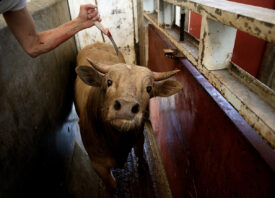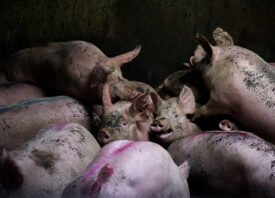Search this site
A Photographer Exposes the Unbearable Cruelty of Pig Farming


In 2018, the animal photojournalist Aitor Garmendia and his colleague, the undercover investigator Linas Korta, happened upon a Spanish pig farm while working on a story about slaughterhouses. When they approached, they found the entrance of the farm marked by a container of corpses, and together, they opened the lid.
Inside, surrounded by dead bodies and excrement, they discovered a single living piglet, weeks old and trembling. They wrapped his shivering body in their clothes and rushed him to the vet. He died hours later.
Months after this encounter, from 2019 to 2020, Garmendia, along with a team of investigators who chose to remain anonymous, would document the conditions in thirty-two Spanish pig farms as part of another investigation. Some facilities contained all phases of the production cycle, from gestation to fattening, while others were designed for a specific phase. In all, he found suffering.
“We accessed these farms at night and without permission,” the photojournalist explains. “When you approach a pig farm, even when it’s dark, you know where you are because of the smell. It is unmistakable.” The investigative team stayed organized throughout the process. “Some members of the team go inside while others stay outside, keeping watch,” he says. “We all communicate by radio, and everyone knows what to do in case something happens. Everything is discussed before entering.”
The life of a farmed pig begins in a gestation crate, an iron cage with a concrete floor where sows are inseminated. A sow is usually inseminated for the first time at around eight months old. If she becomes pregnant, she will stay in the crate for four weeks; if not, she will be inseminated again.
“Gestation cages consist of metal frames that prevent sows from turning around,” Garmendia says. “They can only stand up or lie down.” Sometimes, their legs are crushed. In these crates, the photographer saw stereotypic behaviors like bar biting, head bobbing, tongue rolling, and more to indicate mental distress.
A week before they give birth, the sows are then moved to farrowing crates for three to four weeks; these crates largely prevent the natural physical bonding between mother and child. Sometimes, Garmendia explains, a sow will give birth in her own accumulated feces. During this time, piglets can die from hypothermia, crushing, or starvation. The photographer and the anonymous investigators found the bodies of piglets tossed in corridors, wheelbarrows, and buckets. Some had been left inside the enclosures, alongside their still-living siblings.
The piglets who survive this stage are forcibly weaned and removed from their mothers as part of the cycle. The sows are then inseminated again. In the first seven days of their life, piglets can be legally castrated, as well as have their tails docked (partially amputated) and teeth cut, without anesthesia.
From there, the pigs are moved to transition areas, where they are vulnerable to bacterial disease; during this phase, Garmendia saw pigs exhibiting symptoms like leg shaking, seizures, tremors, emaciation, and apparent weakness. “It is very common to meet pigs, mainly a few weeks old, separated in corners or in corridors, in agony and convulsing,” he says.
Finally, the photojournalist and the investigators visited fattening areas, where the pigs lived in large sheds, on dirty concrete floors. “The smell was hardly bearable, even with masks,” he says. It was here that he also discovered numerous health and welfare conditions, including but not limited to rectal prolapse; hernias and abscesses; conjunctivitis and other eye conditions; infections; respiratory distress; and open, necrotic wounds.
The investigators also witnessed caudophagia, or tail-biting, among pigs. “This abnormal behavior occurs when they are deprived of suitable environmental conditions and their exploratory behavior is directed towards other pigs,” Garmendia says. Caudophagia can lead to serious injuries, infections, and sometimes cannibalism among pigs. On one farm, the photographer found a group of pigs eating the corpse of a deceased pig.
Throughout these phases in the production cycle, millions of pigs die before ever reaching the slaughterhouse. Some die of these illnesses, and some are “euthanized” if treatment is not deemed profitable; methods of euthanasia might include the use of a captive bolt pistol, a blow to the head with a heavy object, asphyxiation by gas, the use of a free projectile weapon, or lethal injection.
There were some activities, like tail docking and castration, that he was unable to document as part of this investigation. “I requested permission from several farmers to document these standard practices that take place under the industrial exploitation of pigs, and all refused,” he admits. “The vast majority allude to the same thing: if those images come to light, it will damage their business.”
As Garmendia explains, existing welfare laws do not protect pigs from suffering. “If society does not have this information, we cannot expect any profound or conscious change, and that is exactly what animals need,” he says. “As advocates, we cannot keep waiting for changes to come from the same system that oppresses people and animals. It’s up to us to organize, create networks, and build a strong social movement.”
I ask him again about the trembling piglet he met years ago now, hidden in the corpse container outside that farm he found with Linas Korta. “By the time we found him and took him to the vet, he already had a serious health problem,” he tells me. “He only lived a few hours, but we had the time to name him and imagine him free in a sanctuary. He was born with a number, but he died with a name.”
Read Aitor Garmendia’s report on pig farming here. Follow his work via his website, Tras los Muros, and on Instagram at @traslosmuros.









